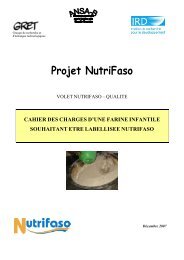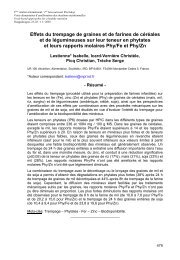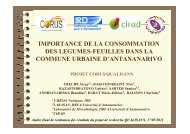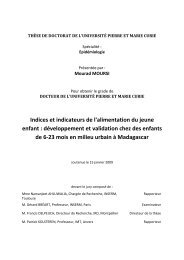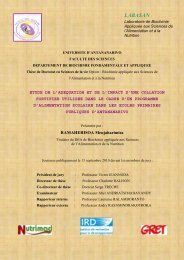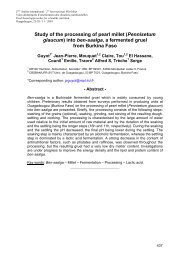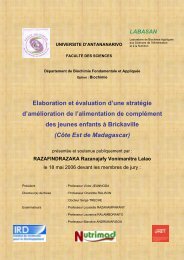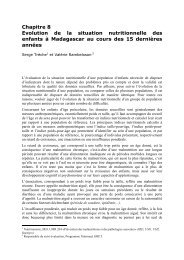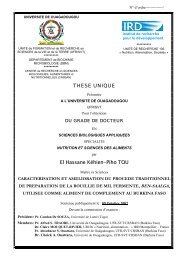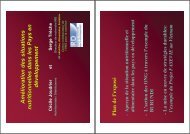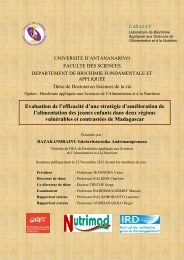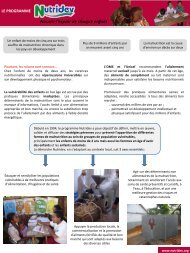Implementation and Evaluation of Complementary Food ... - Nutridev
Implementation and Evaluation of Complementary Food ... - Nutridev
Implementation and Evaluation of Complementary Food ... - Nutridev
- No tags were found...
Create successful ePaper yourself
Turn your PDF publications into a flip-book with our unique Google optimized e-Paper software.
Optimizing Early Child Nutrition – Singapore - June 26, 2002Strategies in making complementary food programs work<strong>Implementation</strong> <strong>and</strong> <strong>Evaluation</strong> <strong>of</strong><strong>Complementary</strong> <strong>Food</strong> programsEfficacy <strong>and</strong> effectiveness studies,impact assessmentEvidence-based case studyJacques BergerInstitute <strong>of</strong> Research for DevelopmentFrance / Viet NamFunctions <strong>of</strong> evaluationFormative evaluationFine tuning program implementation To judge how the program is planned <strong>and</strong>executed To improve <strong>and</strong> develop program activitiesas they are carried out1
Functions <strong>of</strong> evaluationSummative evaluationMeasures the outcome / impact <strong>of</strong> the program To make decision about the program evaluated:change, exp<strong>and</strong> or end the program. To address the specific questions <strong>of</strong> concern <strong>of</strong>decision makers. To satisfy the program sponsors<strong>Evaluation</strong> <strong>of</strong> a programSystematic collection <strong>and</strong> delineation <strong>and</strong> use <strong>of</strong>information to judge the correctness <strong>of</strong> thesituation analysis, critically assess theresources <strong>and</strong> strategies selected, to providefeedback <strong>of</strong> the process <strong>of</strong> implementation <strong>and</strong>to measure effectiveness <strong>and</strong> the impact <strong>of</strong> anaction program (Oshaugh, 1992).Links the evaluation activities to a specificprogram (Fasevie program)2
Target audience <strong>of</strong> the evaluation‣ Policymakers (National authorities)‣ Program managers‣ Community groups, leaders, mothers International organizations Donor agencies / sponsors International scientific communityEach target group may expect differentinformation3
Situation analysis‣ High prevalence <strong>of</strong> growth retardation, irondeficiency anemia <strong>and</strong> vitamin Adeficiency in infants <strong>and</strong> children inVietnam‣ National plans <strong>of</strong> Action for Nutrition1995 - 2000 / 2001 - 2010, <strong>and</strong>its corollary "National Plan <strong>of</strong> Action for<strong>Food</strong> Fortification in Vietnam 2001-2005".Local situation analysissurveys• Nutritional status deterioratesin early life• Too early introduction <strong>of</strong> foods• Insufficient use <strong>of</strong> special transitional foods• Use <strong>of</strong> inappropriate complementary foods <strong>of</strong>low nutritional quality• Absence <strong>of</strong> appropriate quality, low costcomplementary foods• Weakness <strong>of</strong> nutritional knowledge (<strong>and</strong>practices) <strong>of</strong> mothers4
Local situation analysissurveys• Weakness <strong>of</strong> income but interest forprocessed complementary foods• Willingness <strong>of</strong> local authorities• Strong “social network”• Interest <strong>of</strong> potential producers• Large range <strong>of</strong> local raw materials• Use <strong>of</strong> boiling water• Existing low-cost technology, large range <strong>of</strong>packaging producersObjective <strong>of</strong> the Fasevie programTo promote the use <strong>of</strong> adequate feedingpractices <strong>and</strong> complementary foods by infants<strong>and</strong> young children in population with limitedeconomic resources in three provinces <strong>of</strong> thecentral region <strong>of</strong> Vietnam (Ha Tinh, Da Nang <strong>and</strong>Quang Nam) to reduce stunting by 10% <strong>and</strong>prevent micronutrient deficiencies in infants <strong>and</strong>young children in two years after start <strong>of</strong>implementation.5
Production activitiesTraining <strong>of</strong> workersInputProduction evaluation / quality control‣ HACCP: complete quality control systemDaily‣ Nutrient composition <strong>and</strong> microbiology(internal + external) Monthly+r<strong>and</strong>omComposition (Micronutrients)IRD‣ Production monitoring: hygiene, safety,workers securityTwice monthly8
ProductsInstant floursmade with local raw materials:Rice (52%), soybean (21%), sesame (5%), sugar (15%),dried whole milk (5%), salt (0.7%), VM premix (1.3%)0.8 USD / 400 g0.4 USD / 250 gPreparation <strong>of</strong> gruel with appropriateviscosity, high energy density <strong>and</strong> digestibility, fortifiedwith Vitamins <strong>and</strong> MineralsProducts<strong>Food</strong> complementSoybean (87.7%), Ca3(PO4)2 (6.1%),salt (3.1%), food grade amylase, VMpremix (3.5%)Bot (younger infants)Rice flour + Favilase + watercooked for 15 mn0.35 USD / 150 gGruelsChoa (older children)Rice grains cooked for 1h inexcess <strong>of</strong> water + Favilasecooked for 10 mn9
Attraction <strong>of</strong> the products714 households, questionnaire‣ Taste, color (+ sensorial analysis)‣ Easiness <strong>of</strong> use‣ Text (informative) change‣ InstructionsPackagingLabelPrice (80% Ok)Promotion <strong>of</strong> complementary feeding throughcommunity volunteers network (social marketing)teamMedical Doctor + Trainerspecialized in nutrition educationProvinceMedical doctor ( health center) +Vice-president <strong>of</strong> Women UnionDistrict 1 main trainer + 1 WU volunteerSimple message: nature <strong>and</strong> consequences <strong>of</strong>malnutrition, importance <strong>of</strong> breast-milk <strong>and</strong> appropriatecomplementary feeding practices (EBF, CF)Commune1 WU volunteerVillage1 volunteer / 20 mothersHouseholds Individual visitsMessage adapted to the age <strong>of</strong>infants10
Social marketingTraining <strong>of</strong> volunteersNutrition Education manual11
Nutrition EducationmanualNutrition Educationmanual12
<strong>Evaluation</strong>Follow-up books(monthly indicators)followed by actionSustainability:10% margin on saleWorks for Favina not forFavilasePromotion <strong>of</strong> the food complement throughcanteen system (SM)To avoid competition<strong>of</strong> instant flour withfood complement1. Only Favilase incanteens2. Both productsNutritional educationmanual13
<strong>Evaluation</strong>Follow-up books(monthly indicators)followed by actionSustainability:10% margin on salePromotion <strong>of</strong> instant flours throughmarketing networkSales workers (salary from the program for 4months)1500 boxes / month(500 Vnd margin)Sale retail shopsFollow-up: book <strong>of</strong>sales coverage14
Integration <strong>of</strong> Fasevie approachFasevie products used by the Nationalmalnutrition program (Child <strong>and</strong> MotherProtection Center)Volunteers from Women Union participate toboth Fasevie <strong>and</strong> CMPC programsUse <strong>of</strong> the Fasevie products in emergencyprograms (WFP, International Plan, MSF)Summative evaluationMeasure the performance <strong>and</strong> the impact <strong>of</strong> theprogramThe final goal being to assess the effectiveness<strong>of</strong> the program, i.e. large-scale achievements <strong>of</strong>intervention, which, under ideal controlledconditions, have a known efficacy15
Performance <strong>of</strong> the program‣ Provision indicators: sustainability <strong>of</strong>production units, quality <strong>and</strong> availability <strong>of</strong>products‣ Coverage indicators: proportion <strong>of</strong> thepopulation in the intervention districts thatbenefited from social marketing approachesIndividual visits: 600 to 1200 mothers / month‣ Utilization indicators: sale <strong>of</strong> the productsSale: 1000 to 2000 boxes <strong>of</strong> Favina / monthImpact <strong>of</strong> the programChanges (improvement) in health, nutritionalstatus <strong>and</strong> feeding practicesrelated to the programEfficacy studyEffectiveness study16
Efficacy studyTam Ky district, 36 villages r<strong>and</strong>omly divided in 3 groups+ nutritioneducationFavina gruel Rice gruel Usual feedingwith Favilase practicesControl group 2 meals/day under supervision No intervention+ Nutrition educationSubjects: 5 months old breastfed infants , 128 per groupEfficacy studyDistribution <strong>of</strong> meals through canteens (7 AM- 6 PM)17
Efficacy studyDuration <strong>of</strong> enrolment / inclusion: 8 monthsDuration <strong>of</strong> intervention: 6 months, started December 2001Duration <strong>of</strong> follow-up: 6 to 12 monthsVariables: Blood sampling at baseline <strong>and</strong> after 6 months(Hb <strong>and</strong> serum Ferritin, Transferrin receptor,Retinol, Zinc) Anthropometry at the age <strong>of</strong> 5, 8, 11 <strong>and</strong> 17 monthsEfficacy study Quantity <strong>of</strong> instant flour / gruel with food complementconsumed Daily Morbidity Feeding practicesDailyWeekly <strong>Food</strong> consumption (Energy <strong>and</strong> nutrient intake)at 6, 7, 8 <strong>and</strong> 9 months <strong>of</strong> age Socio-economic situation <strong>of</strong> the householdInformed consent from mother / fatherAgreement <strong>of</strong> Scientific Committees <strong>of</strong> Medical School<strong>and</strong> NIN18
Hemoglobin distribution at baselineAnemia 66 %Hemoglobin (g/L) at baseline <strong>and</strong> after 6months <strong>of</strong> intervention120115Anemia T6 (%)14.311028.610557.11009590T0T6FavinaFavilaseControl19
part <strong>of</strong> integrated strategies‣ Multi-micronutrient supplementation <strong>of</strong> infants (IRIS 1)‣ Iron - Vitamin A fortification <strong>of</strong> biscuits for schoolschildren (Sight <strong>and</strong> Life)‣ Iron fortification <strong>of</strong> fish sauce (ILSI-CHP / ILSI-Japan)‣ Preventive weekly iron-folate supplementation in WRA(WHO)22



